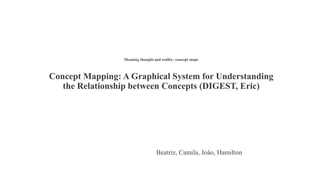Topicos de semantica
- 1. Meaning thought and reality: concept maps Concept Mapping: A Graphical System for Understanding the Relationship between Concepts (DIGEST, Eric) Beatriz, Camila, JoÃĢo, Hamilton
- 2. Definition and structure âĒ A concept map is a graphical representation where nodes (points or vertices) represent concepts, and links (arcs or lines) represent the relationships between concepts. The concepts, and sometimes the links, are labeled on the concept map. The links between the concepts can be one-way, two-way, or non-directional. The concepts and the links may be categorized, and the concept map may show temporal or causal relationships between concepts.
- 3. Concept mapping purposes: âĒ To generate ideas (brainstorming); âĒ To design complex structures (long texts, hypermedia, large web sites); âĒ To communicate complex ideas; âĒ To aid learning by explicitly integrating new and old knowledge; and âĒ To assess understanding or diagnose misunderstanding.
- 4. Advantages of concept mapping âĒ Visual representation has several advantages: âĒ Visual symbols are quickly and easily recognized; âĒ Minimum use of text makes it easy to scan for a word, phrase, or the general idea; and âĒ Visual representation allows for development of a holistic understanding that words alone cannot convey.
- 5. Applications of concept mapping âĒ (1) Creativity Tool âĒ (2) Hypertext Design Tool âĒ (3) Communication Tool âĒ (4) Learning Tool âĒ (5) Assessment Tool
- 8. References âĒ http://www.ericdigests.org/1998-1/concept.htm âĒ http://www.webspirationclassroom.com/launch.php âĒ http://electra.ihmc.us/servlet/SBReadResourceServlet?rid=10252000 33313_1835371134_1512&partName=htmltext








